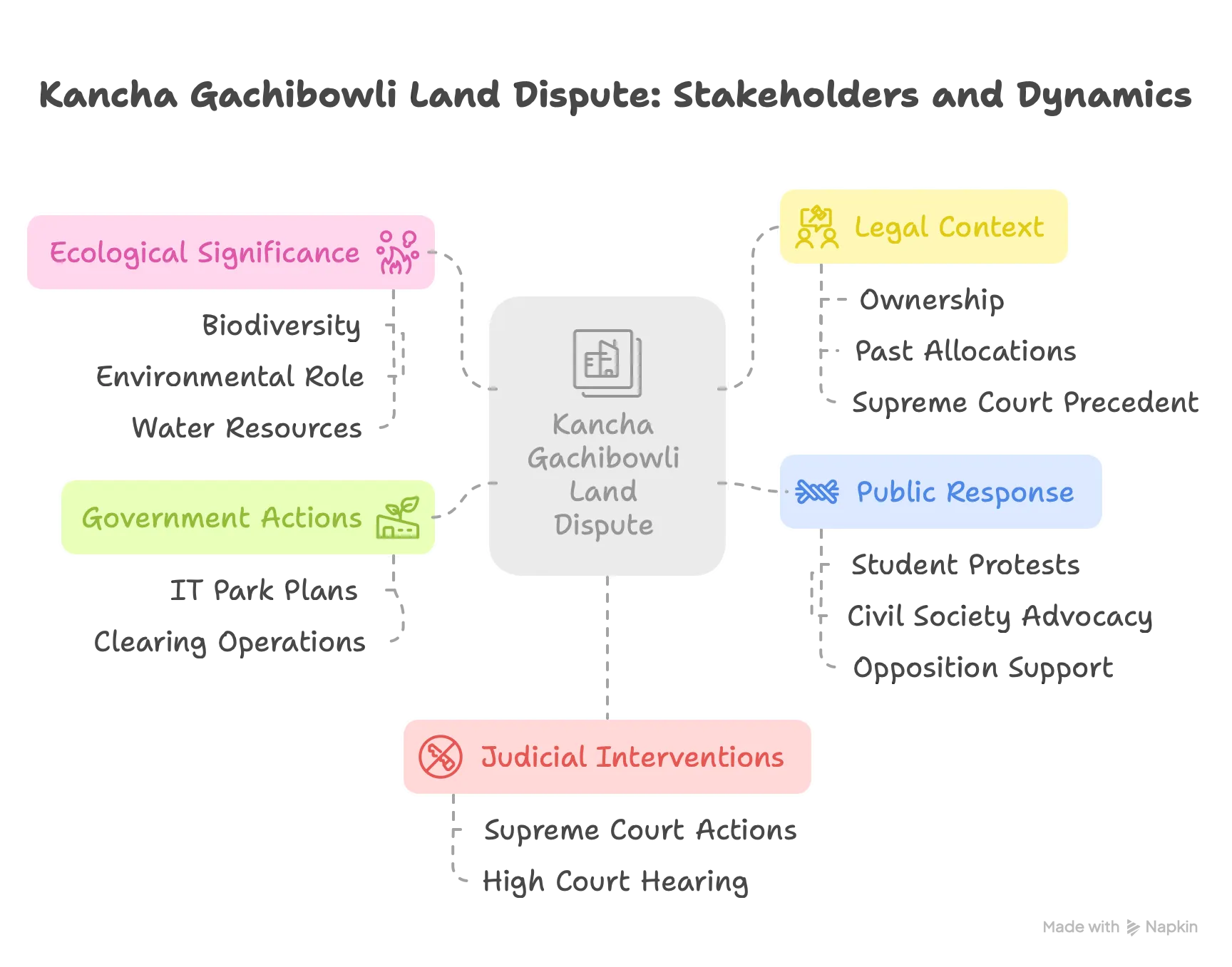UPSC
Indian Express Concise
Kancha Gachibowli Forest Dispute: Balancing Development and Ecology
Last Updated
6th April, 2025
Date Published
6th April, 2025
Share This Post With Someone

The Kancha Gachibowli forest issue in Hyderabad highlights the tension between urban development and environmental conservation, a recurring theme in India’s policy landscape. This summary, based on an article from The Indian Express dated April 6, 2025, details the controversy over the Telangana government’s plan to auction 400 acres of forested land, the resulting protests, legal interventions, and ecological stakes, offering insights into governance, environmental law, and public mobilisation.

Key Points:
Background of the Dispute
- Location: Kancha Gachibowli, an urban forest adjacent to the University of Hyderabad (UoH) in Hyderabad’s IT corridor.
- Government Plan: In February 2025, the Telangana government announced an auction of 400 acres to develop IT parks, aiming to boost economic growth.
- Land History: Originally part of 2,300 acres allotted to UoH in 1974, the 400 acres were transferred to a private sports firm in 2003, reclaimed in 2006, and legally affirmed as state-owned after a Supreme Court ruling.
Ecological Significance
- Biodiversity: Home to numerous bird, mammal, and reptile species, including peacocks, deer, and rare flora, with unique rock formations.
- Environmental Role: Acts as a carbon sink, regulates local climate by providing shade, reducing temperatures, and increasing humidity.
- Water Resources: Part of the Musi river basin, with three lakes (Peacock Lake, Buffalo Lake) and high groundwater potential (15.62 meters in March 2025 vs. 10.8 meters in nearby Gachibowli).
Legal and Ownership Context
- Ownership: Telangana government is the sole legal owner, though the 400 acres remain undemarcated and unnotified as forest land.
- Past Allocations: Portions of the original 2,300 acres were used for a bus depot, telephone exchange, IIIT campus, sports stadium, and shooting range.
- Supreme Court Precedent: The 1996 T.N. Godavarman Thirumulpad vs. Union of India ruling classifies any forested land as “forest,” regardless of notification, supporting conservation arguments.
Protests and Public Response
- Student Protests: UoH students launched massive protests against the auction, citing loss of green cover and biodiversity.
- Civil Society: Groups like Save City Forest advocate for preservation, proposing it be declared a National Park, akin to Hyderabad’s Kasu Brahmananda Reddy National Park.
- Opposition Support: Bharat Rashtra Samithi (BRS) backed the protests, criticizing police action and ecological damage.
Government Actions and Deforestation
- Clearing Operations: Began on March 30, 2025, with earthmovers leveling 100 acres, despite environmental concerns.
- Economic Goals: Auction expected to generate Rs 10,000-15,000 crore and create 5 lakh jobs, per government estimates.
- CM’s Stance: A. Revanth Reddy dismissed wildlife claims, alleging political motivation behind protests, and emphasized development needs.
Judicial Interventions
- Supreme Court (April 3, 2025):
- Took suo motu cognizance, halted “alarming deforestation activities,” and ordered no further action except tree protection.
- Sought explanation from Telangana’s Chief Secretary on the urgency of clearing, directed a Central Empowered Committee to report by April 16, 2025.
- High Court registrar’s ground report confirmed extensive tree-felling and biodiversity presence.
- Telangana High Court: Postponed hearing to April 7, 2025, after an earlier pause order was ignored.
Government Response Post-SC Order
- Ministerial Committee: Formed on April 3, 2025, with ministers Mallu Bhatti Vikramarka, D. Sridhar Babu, and Ponguleti Srinivas Reddy to consult stakeholders (UoH, JAC, civil society, students) for a resolution.
- Policy Shift: Post-SC stay, plans shifted to potentially develop an eco-park over 2,000 acres, including UoH land, with UoH relocation proposed.
Environmental and Legal Concerns
- Violations Alleged: Clearing without environmental impact assessment (EIA) or clearance breaches wildlife and environmental laws.
- Conservation Demand: Activists cite the presence of Schedule-I species, urging formal forest status to prevent future deforestation.
- Urban Impact: Loss of this “lung space” could worsen Hyderabad’s pollution and heat island effects.
Glossary
- Kancha Gachibowli: A 400-acre urban forest near UoH, central to the Hyderabad dispute.
- Carbon Sink: Natural system absorbing more carbon dioxide than it releases, aiding climate regulation.
- T.N. Godavarman Case (1996): Supreme Court ruling defining forested land as “forest” regardless of legal status.
- EIA: Environmental Impact Assessment - Study to evaluate ecological consequences of development projects.
- Schedule-I Species: Wildlife species under the highest protection level in India’s Wildlife Protection Act, 1972.
- Urban Lung Space: Green areas in cities that improve air quality and reduce urban heat.
- Suo Motu: Legal action initiated by a court on its own accord, without a formal petition.
Link To The Original Article – https://indianexpress.com/article/explained/kancha-gachibowli-forest-issue-9926884/